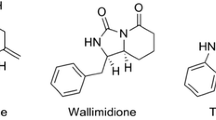Abstract
Samples of building materials visibly contaminated with moisture-related fungi (drywall, fiberglass, wallpaper, wood) were tested with indirect (FFL) and direct (MTT) cytotoxicity screening tests that are particularly sensitive toStachybotrys chartarum toxins. In addition, microscopic, chemical, immunochemical (Roridin A enzyme immunoassay) and mycological culture analyses were performed. In all cases in which building occupants had reported verifiable skin, mucous membrane, respiratory, central nervous system or neuropsychological abnormalities, cytotoxicity was identified. Results of a cytotoxicity screening test of field samples, such as the direct MTT test method, will give investigators of health problems related to indoor air quality problems important toxicity information.
Similar content being viewed by others
References
Ueno Y (1983) Trichothecenes - Chemical,Biological and Toxicological Aspects. Elsevier Publisher, Amsterdam, 135–194.
Husman T (1996) Health effects of indoor-air microorganism. Scand J Work Environ Health 22: 5–13.
Reijula K (1996) Building with moisture problems - a new challenge to occupational health care. Scand J Work Environ Health 22: 1–3.
Sorenson B (1990) Mycotoxins as potential occupational hazards. Developments in Industrial Microbiology, Journal of Industrial Microbiology, Suppl. No. 31:205–211.
Nikulin M; Reijula K; Jarvis B; et al. (1997) Effects of Intranasal Exposure to Spores of Stachybotrys atra in Mice. Fundamental and Applied Toxicology 35:182–188
Yang CS; Johanning E (1997) Airborne Fungi and Mycotoxins. Pp. 651–660. Hurst CJ; Knudsen GR; Mclnerney MJ; et al.: Manual of Environmental Microbiology. ASM Press, Washington, D.C.
Montana E; Etzel RA; Allan T; et al. (1997) Environmental Risk Factors Associated with Pediatric Idiopathic Pulmonary Hemorrhage and Hemosiderosis in a Cleveland Community. Pediatrics 99:1–8.
Center for Disease Control and Prevention (1997) Update on Pulmonary Hemorrhage/Hemosiderosis among Infants-Cleveland Ohio, 1993-1996. Morbidity and Mortality Report, Vol. 46, No.2. January 17, 1997.
Sorenson B; Kullman G; Hintz P (1997) NIOSH Health Hazard Evaluation Report. HETA 95-0160-2571. Center for Disease Control and Prevention. National Center for Environmental Health. U.S. Department of Health and Human Services. Morgantown, W.VA., April 1996.
Johanning E; Biagini R; Hull D; et al (1996) Health and immunology study following exposure to toxigenic fungi (Stachybotrys atra) in a water-damaged office environment. Int Arch Occup Environ Health 68:207–218.
Corrier DE (1991) Mycotoxicosis: Mechanism of immunosuppression. Vet Immunopathol 30: 73–87.
Nikulin M; Pasanen AL; Berg S; et al. (1994) Stachybotrys atra growth and toxin production in some building materials and fodder under different relative humidities. Appl. Environ. Microbiol. 60: 3421–3424.
Hanelt M; Gareis M; Kollarczik B (1994) Cytotoxicity of mycotoxins evaluated by the MTT-cell culture assay. Mycopathologica 128: 167–174.
Gareis M (1995) Cytotoxicity Testing of Samples Originating from Buildings. In: Johanning E; Yang CS (Editors): Fungi and Bacteria in Indoor Air Environments. Prodeeding of the International Conference, Saratoga Springs, New York. October 6-7, 1994. Published by Eastenr New York Occupational Healt Program, Albany, N.Y.
Pasanen AL, Nikulin M, Tuomainen M, et al. (1993) Laboratory experiments on membrane filter sampling of airborne mycotoxins produced by Stachybotrys atra Corda. Athmospheric Environment 27A:9–13.
Jarvis BB, Salemme J, Morais A (1995) Stachybotry toxins. 1. Natural Toxins 3: 10–16.
Märtlbauer E; Gareis M; Terplan G (1988) Enzyme Immunoassay for the Macrocyclic Trichothecene Roridin A: Production, Properties, and Use of Rabbit Antibodies. Applied and Environmental Microbiology 54: 225–230.
Hack R; Märtlbauer E; Terplan G (1988) Production and Characterization of Monoclonal Antibodies to the Macrocyclic Trichothecene Roridin A. Applied and Environmental Microbiology 54: 2328–2330.
Gareis M (1993) Mycotoxins in animal feeds and effects on livestock. In: Scudamore K (ed) Occurrence and Significance of Mycotoxins. Proc UK Workshop, April 21-23, 1993, Brunel University of West London. 7–15.
Cole RJ, Cox RH (1981) Handbook of Toxic Fungal Metabolites. Academic Press, New York.
Hendry KM, Cole EC (1993) A review of Mycotoxins in indoor air. J Toxicol Environ Health 38: 193–98.
Moss MO (1996) Mycotoxins. Centenary Review. Mycol Res. 100: 513–523.
Sorenson WG; Frazier DG; Jarvis BB; et al. (1987) Trichothecene mycotoxins in aerosolized conidia of Stachybotrys atra. Appl Environ Microbio 53: 1370–5.
Reubel GH; Gareis M; Amselgruber WM (1987) Cytotoxicity Evaluation of Mycotoxins by an MTT-Bioassay. Mycotoxin Research 3: 85–96.
Bauer J; Gareis M (1989) Untersuchungsmethoden für Mykotoxine (Analytical Methods for Mycotoxins). Dtsch tierärztl Wschr 96: 333–396.
Andersson MA; Nikulin M; Köljalg U; et al. (1997) Bacteria, Molds, and Toxins in Water-Damaged Building Materials. Applied and Environmental Microbiology. 63:387–393.
Jacobs RR (1997) Endotoxins in the Environment. International J Occup Environ Health (1):S3–S5. Suppl.
Rylander R (1997) Evaluation of the Risks of Endotoxin Exposure. International JOccup Environ Health 3 (1):S32-S36. Suppl.
Rylander R, Fogelmark B (1994) Inflammatory Responses by Inhalation of Endotoxins and (l-3)-β-D-Glucans. Amer I Ind Med 25: 101–102.
Miller JD; Young J (1997) The Use of Ergosterol to Measure Exposure to Fungal Propagules in Indoor Air. Am Ind Hyg Asso J 58: 39–43.
Author information
Authors and Affiliations
Corresponding author
Rights and permissions
About this article
Cite this article
E, J., M, G., S, Y.C. et al. Toxicity screening of materials from buildings with fungal indoor air quality problems (Stachybotrys chartarum). Mycotox Res 14, 60–73 (1998). https://doi.org/10.1007/BF02945095
Received:
Accepted:
Issue Date:
DOI: https://doi.org/10.1007/BF02945095




